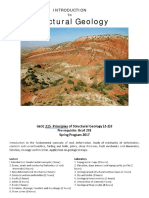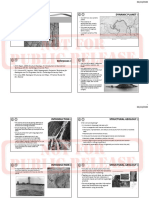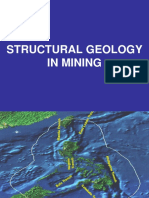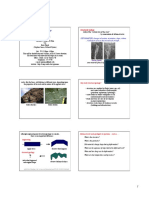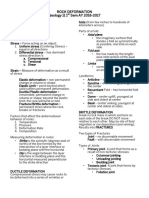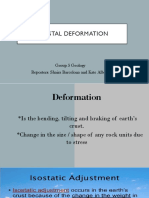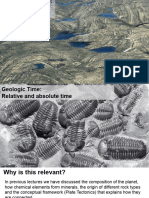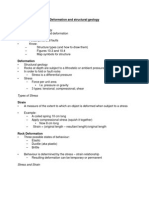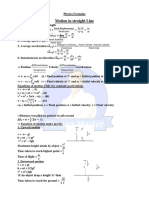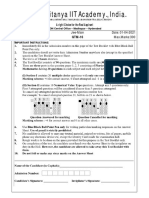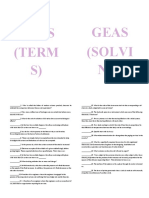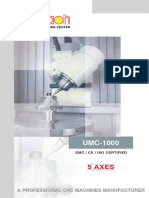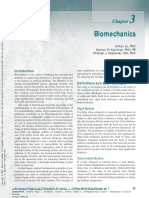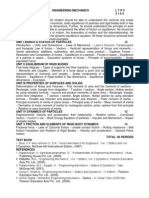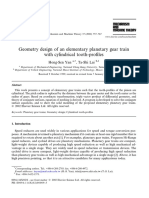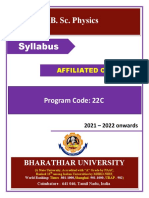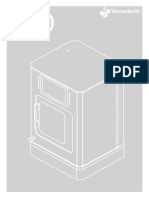GY403 Structural Geology
Lecture 1: Introduction
�Nature of Structural Geology
Study of Deformation
What was the rock like before deformation? What forces were required to deform the rock? How long and in what order did deformation events proceed? How does the deformation relate to global tectonics?
Deformation: change in shape and/or volume in a rock mass. Strain is synonymous with deformation.
�Plate Tectonics & Structural Geology
Orogenic Belts: produced along a convergent plate boundary. Orogenic belts are the focus of structural geology because they record long periods of multiple deformation events. The strain in orogenic belts is primarily an effect of distortion (i.e. change in shape) as opposed to dilation (i.e. change in volume)
�Fundamental Structures
Contacts: boundaries that separate one rock body from another. Primary Structures: structures that are produced during formation of rock body.
Depositional contact Unconformable contact Cross bedding Vesicles in basalt
�Fundamental Structures cont.
Secondary structures: structures produced after the rock body that they affect.
Fault contacts Folds Joints and shear fractures Tectonite fabric (cleavage, foliation and/or lineation)
�Faults
Fault: a fracture displaying significant apparent offset of structures Cataclasite: fragmented rock produced by the grinding action of a fault at low pressure (low depth) activity Mylonite: recrystallized rock generated by deep (high pressure) fault motion Ductile Shear Zones: fault zone rocks that contain mylonites that deform in a ductile manner
�Faults cont.
Measurable offsets are present along faulted contacts
�Folds
Folds: formed when beds or fabric are deformed into curved or bent geometries on virtually any scale. Fold Mechanisms:
Compression due to tectonic forces Drag folding in fault zones Syn-depositional slumping Intrusion of magma or other viscous materials Mass wasting
�Folds cont.
Folds are documented by measurement of hinge and axial trace attitude, wavelength distance
Hinge line (trend & plunge)
Interlimb angle
Fold limbs (strike & dip)
Axial trace (strike)
�Joints & Shear Fractures
Joint: a fracture where there has been no apparent slippage (i.e. no offset is apparent) Shear fracture: a fracture that displays a small amount (< cm) of apparent offset Note: before designating a shear fracture make sure to investigate all 3D possibilities for slip
�Joint Fractures cont.
Produced by expansion during erosional unloading
�Tectonite Fabric
Tectonite Fabric: a cleavage, foliation and/or lineation that is pervasive in a rock mass. Tectonite fabrics are produced by the directed stress set up by plate tectonics, and are usually found in regional metamorphic rocks
�Cleavage
Slaty cleavage axial planar to fold
Axial Plane
Slaty Cleavage
�Foliation
Foliation: preferred alignment of mineral grains
Foliation
�Stretch-Pebble Metaconglomerate
Alignment of stretched pebbles in metaconglomerate
�Concept of Detailed Structural Analysis
Descriptive Analysis: recognizing and describing structures and measuring their locations, geometries, and orientations. Kinematic Analysis: interpretation of the deformational movements in a rock mass necessary to produce deformational structures.
Translation (described by a linear vector) Rotation (described by axis, amount and sense of rotation) Dilation (Volume change; +V= volume gain) Distortion (change in shape)
Dynamic (Force) Analysis: role of forces driving deformation Tectonic Analysis: developing tectonic models for the evolution of the Earth over time
�Kinematic Analysis Components
Rigid Body
Translation (Vector) Rotation (Axis, Amount & Sense of Rotation)
Non-Rigid Body
Dilation (Volume) Distortion (Shape)
�Scale
�GSA Geological Time Scale (2009)
�Geologic Time Scale Summary
Eons: Hadean (4.56-3.95Ga), Archean (3.952.5Ga), Proterozoic (2.5Ga-542Ma), Phanerozoic (542Ma-present) Eras: Paleozoic (542-251Ma), Mesozoic (25165.5Ma), Cenozoic (65.5Ma-present) Periods: Cambrian(542Ma), Ordovician (488Ma), Silurian(439Ma), Devonian(416Ma), Mississippian(359Ma), Pennsylvanian(318Ma), Permian(299Ma), Triassic(251Ma), Jurassic(201.6Ma), Cretaceous(145.5Ma), Tertiary(65.5Ma), Quaternary(2.6Ma)
�Summary of Items to Know for Exams
Geologic Time Scale (Eons, Eras, Periods and boundary dates) Components of Structural Analysis
Descriptive, Kinematic, Dynamic, Tectonics Examples of each
Components of Kinematic Analysis
Translation, Rotation, Dilation, Distortion Geological examples of Each Rigid Body vs. Non-Rigid Body deformation
Fundamental Structures (know examples)
Primary structures Secondary structures



















